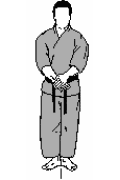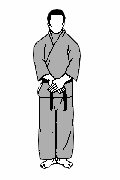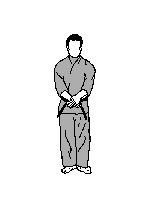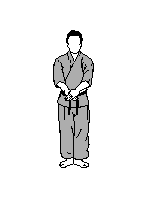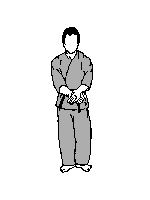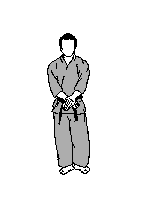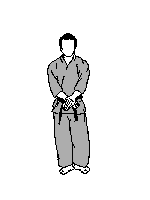


Suchy Kensei Shihan
Okinawakan Goju Ryu Karate Do Kobujutsu Hozon Kai
Nakamoto Kiichi Hanshi
Haz tu reserva vía Whatsapp Ya!
Que es Karate?
Karate (空手?) (inglés /kəˈrɑːtiː/; pronunciación japonesa: [kaɽate] (escuchar); pronunciación de Okinawa: IPA: [kaɽati]) es un arte marcial desarrollado en las Islas Ryukyu en lo que ahora es Okinawa, Japón. Se desarrolló a partir de las artes marciales indígenas de las Islas Ryukyu (llamadas te (手?), Literalmente "mano"; tii en Okinawa) bajo la influencia de las artes marciales chinas, particularmente la Grulla Blanca de Fujian.[1][2] El karate es ahora predominantemente un arte llamativo que utiliza puñetazos, patadas, golpes de rodilla, golpes de codo y técnicas de mano abierta, como manos con cuchillo, manos con lanza y golpes con el talón de la palma. Históricamente y en algunos estilos modernos también se enseñan agarres, lanzamientos, bloqueos de articulaciones, restricciones y golpes en puntos vitales.[3] Un practicante de karate se llama karateka (空手家?). Karate desarrollado en el Reino de Ryukyu. Fue traído al continente japonés a principios del siglo XX durante una época de intercambios culturales entre japoneses y chinos. En 1924, la Universidad de Keio estableció el primer club universitario de kárate en Japón continental y, en 1932, las principales universidades japonesas tenían clubes de kárate.[5] En esta era de escalada del militarismo japonés,[6] el nombre se cambió de 唐手 ("mano china" o "mano Tang")[7] a 空手 ("mano vacía"), los cuales se pronuncian karate, para indicar que los japoneses deseaban desarrollar la forma de combate al estilo japonés.[8] Después de la Segunda Guerra Mundial, Okinawa se convirtió en un sitio militar importante de los Estados Unidos y el karate se hizo popular entre los militares estacionados allí.[9] Las películas de artes marciales de las décadas de 1960 y 1970 sirvieron para aumentar en gran medida la popularidad de las artes marciales en todo el mundo, y en inglés la palabra karate comenzó a usarse de manera genérica para referirse a todas las artes marciales orientales basadas en golpes.[10] Las escuelas de karate comenzaron a aparecer en todo el mundo, atendiendo tanto a aquellos con un interés casual como a aquellos que buscaban un estudio más profundo del arte. Shigeru Egami, instructor en jefe de Shotokan Dojo, opinó que "la mayoría de los seguidores del karate en países extranjeros practican el karate solo por sus técnicas de lucha... Las películas y la televisión... presentan al karate como una forma misteriosa de lucha capaz de causar la muerte o herida con un solo golpe... los medios de comunicación presentan un pseudo arte lejos de lo real".[11] sólo a través de la autodisciplina, el entrenamiento duro y los propios esfuerzos creativos".[12]
Las Técnicas de Tode
Okinawan Karate Master, Motobu Choki 本部 朝基, 1870-1944
1. La mejor edad para comenzar el entrenamiento de Karate-jutsu es a los 12 años. Comenzar a esta edad permite desarrollar las habilidades sistemáticas que son muy deseables cuando uno llega a la edad adulta. Sin embargo, si uno realmente tiene el deseo de aprender las artes marciales, diría que cualquier edad es una buena edad siempre que el estudiante sea serio en sus esfuerzos.
2. Cualquiera que desee estudiar Karate-jutsu siempre debe tratar de trabajar más su lado débil. Creo que un estudiante de artes marciales debe entrenar por lo menos dos veces al día (mañana y tarde) y prestar mucha atención a desarrollar su lado débil para igualar su fuerza.
3. Cualquiera que aprenda Karate-jutsu y tenga un deseo real de dominar las artes marciales debe entrenar todas las mañanas cuando se levante. Debe sentarse en el piso con las piernas cruzadas, tensar los músculos del estómago, extender ambos brazos a la altura de los hombros, mover los brazos de lado a lado, de adelante a lado, y también mover ambos brazos de adelante hacia atrás y de atrás hacia adelante. Al cuerpo. Luego ejercite los brazos de derecha a izquierda y de izquierda a derecha. Repitiendo este ejercicio unas tres veces al día, ambos brazos se pueden desarrollar de manera uniforme.
4. Cualquiera que se esfuerce por aprender Karate-jutsu, siempre debe recordar la posición básica del cuerpo de hachi monji-dachi (la postura del ocho). Incluso durante el entrenamiento, debe tensar los músculos del estómago y permanecer siempre erguido con el pecho hacia afuera, como un verdadero artista marcial. Mantenga esta posición siempre. Se ha dicho que aquellos que practican karate-jutsu diligentemente tienen mucho mejor estructura física y fuerza que el hombre promedio. Esto se debe al entrenamiento diario de controlar la postura y los músculos, y al hacer esto, su cuerpo debe construirse tan fuerte que si se toca suena.
5. Es una actitud imperdonable que el estudiante se queje de la pequeñez o las condiciones del salón de entrenamiento. El que es un verdadero guerrero siempre debe recordar que lo más importante es entrenar. Para elevar el alma y la mente del estudiante y la formación técnica real son tan importantes como un carro necesita dos ruedas. El que tiene el espíritu de un guerrero puede entrenar en un espacio extremadamente pequeño de un ken (6×6 pies). Debe entrenar dos veces al día, mañana y noche. Esto no es nada especial, como un hombre que se lava la cara todas las mañanas cuando se levanta, por lo que un verdadero estudiante de karate-jutsu debe entrenar dos veces al día sin falta.
6. Algunos pueden preocuparse de que un joven estudiante de Karate-jutsu se vuelva incontrolable en su fuerza juvenil y haga un mal uso de su Karate-jutsu para desahogar sus emociones o para castigar a los más débiles, en lugar de protegerse a sí mismo de ser atacado. Sin embargo, quien aprende karate-jutsu con la integridad de un artis marcial (un guerrero) no debe olvidar los propósitos de su entrenamiento. El estudiante de karate-jutsu sin la mente y el alma de un artista marcial es un tonto que viene a comer sin palillos. El estudiante de karate-jutsu siempre debe tener en cuenta el espíritu y los ideales de un artista marcial mientras se esfuerza por mejorar sus habilidades.
7. Karate-jutsu también es una fuente de entrenamiento muy importante para la fuerza espiritual, lo cual es muy útil, ya que es un verdadero arte marcial internacional. Es un hecho bien conocido que muchos estudiantes de Karate-jutsu bien entrenados tienen la notable habilidad de controlarse espiritualmente (física y mentalmente). Como buen ejemplo, un verdadero estudiante de karate-jutsu con la capacidad de concentración espiritual puede detectar los próximos movimientos de su oponente solo mirándolo mientras están involucrados en una pelea real. Esta es la capacidad de prever si el oponente golpeará con su lado derecho o izquierdo o cualquier otro avance que pueda hacer. Un estudiante siempre debe recordar la importancia del autocontrol y tener esto en cuenta cuando practique.
Okinawa Goju Ryu Katas
Geki Sai Dai Ichi Geki Sai Dai Ni
"Atacar y Destruir"
Los Geki Sai Kata fueron formulados por Chojun Miyagi Sensei en 1940 como una forma de ejercicio físico para chicos de secundaria y para ayudar a popularizar Goju-Ryu entre el público de Okinawa. En 1948, después de la Segunda Guerra Mundial, Miyagi Sensei comenzó a enseñar Geki Sai Kata en profundidad como parte regular de Goju-Ryu en su propio dojo. Hasta ese momento, Sanchin fue el primer Kata enseñado en Goju-Ryu. Sanchin Kata es física y mentalmente un Kata exigente y requiere una gran cantidad de tiempo y paciencia para aprender y ejecutar correctamente. Sin embargo, los Geki Sai Kata son más fáciles de aprender y realizar, y contienen técnicas dinámicas que son más atractivas para los jóvenes. Estos Kata contienen el mismo kanji que se encuentra en Saifa. Esto sugeriría que a pesar de que estos Kata fueron diseñados principalmente como una forma de ejercicio, Miyagi Sensei incluyó su comprensión del combate como parte de su composición.
Saifa
"To Smash and Tear to Pieces"
Saifa is the first of the classical combative Kata taught in Goju-Ryu. Goju-Ryu's Kata origins come from the martial arts taught in the Fuzhou area of southern China, largely Crane and Xingyi/Baqua as well as other internal and external martial arts. Kanryo Higaonna Sensei was taught this Kata, along with the other Kata of Goju-Ryu, while he studied in China from 1863-1881 under the direction of RuRuKo ( Xie Zhong Xiang in Chinese) and others. These Kata and martial strategies would become the basis of the the quanfa of Higaonna Sensei, which later Miyagi Sensei would call Goju-Ryu. From an understanding of the grappling and strking techniques of this Kata, Saifa can be interpreted to mean grabbing and tearing of tissue in close-quartered combat.
Sanchin
"Three Battles or Conflicts"
Sanchin translates as "3 Battles" or "3 Conflicts". This has many meanings. First it refers to the struggle to control the body under physical fatigue. With fatigue the mind begins to lose focus and thus the spirit begins to diminsh as well. Therefore Sanchin develops discipline, determination, focus, perserverance and other mental attributes. The Chinese refer to this as Shen (spirit), Shin (mind) and Li (body). Another possible interpretation refers to the "Three Burners" of the body as decribed in Traditional Chinese Medicine (TCM).
One of two "heishu " Kata of Goju-Ryu, Sanchin is probably the most misunderstood Kata in all of Karate. In contrast, it is probably the single most valuable training exercise in Goju-Ryu. Like the other Kata of Goju-Ryu, Sanchin ( Samm Chien in Chinese) can be found in several Chinese arts, particulary the southern styles including four styles of Crane Boxing, Dragon Boxing, Tiger Boxing, Lion Boxing, Dog or Ground Boxing and Monk Fist. Sanchin has such aspects as deep, diaphramatic breathing found in many internal arts as well as external attributes like mechanical alignment and muscular strength.
Because many martial artists have little or no understanding of the true history and nature of the Chinese arts from which Okinawan Goju-Ryu has its roots, Sanchin has become little more than an isometric form performed with dangerous tension and improper breathing techniques.
The original Sanchin that Higaonna Sensei learned from RuRuKo (1852-1930) was performed with open hands and with less emphasis on muscle contraction and "energetic" breathing. With the changes brought about by Emperor Meiji (Meiji Restoration Period 1888-1912), Higaonna Sensei changed the open hands to closed fists as the martial meaning was no longer emphasized. Later Miyagi Sensei would again alter the Kata in pattern alone.
Seiyunchin
"Control, Suppress and Pull"
The name Seiunchin implies the use of techniques to off balance, throw and grapple. It is this understanding that imparts the original intentions of the Kata of Naha-te before the sport alignment of modern Karate. Seiyunchin contains close-quartered striking, sweeps, take-downs and throws. Though the Kata itself is void of kicks, many practitioners make the grave mistake by missing the opportunity to apply any leg technique. Though almost invisible to the untrained eye, the subtleness of "ashi barai" and "suri ashi" can represent footsweeps, parries and traps.
Shisochin
"Four Gates" or "Four Directions of Conflict"
Shisochin translates as "Four Gates" or "Four Directions of Conflict". To leave it at that discounts a truer understanding. The third kanji is the same found in Sanchin and Seiyunchin, which translates as "battle" or "conflict". This lends to a deeper definition of its meaning. The idea of four directions can come from the performance of the four shotei in four directions. It can also represent the four elements represented in Chinese medicine (Acupuncture is one) of Wood, Fire, Metal and Water with man representing Earth. Since this was the science and culture of that period in China when Higaonna and Miyagi both studied in Fuzhou, it would be a great oversight to discount this aspect as a very probable explanation of the Kata's name and martial intent.
Sanseru
"36 Hands"
Sanseru is unique as Miyagi Sensei studied this Kata under a direct student of RuRuKo during his studies in Fuzhou, China beginning in 1916. Sanseru, from its numerical designation, would seem to have its roots in Buddhism. This is not to infer that there is a religious connection or implication with this Kata or Karate, but simply that Buddhism was a part of the culture of the people of that time. It should also be noted that numbers had a very important role in the language of the more ancient Chinese before the invention of kanji.
A more realistic explanation of this and the other numerically named Kata is that they refer to a systematic method and understanding of certain groupings of vital acupressure points. It is this science that the martial arts was based upon and developed.
Feng Yiquan, who lived during the Ming Dynasty (1522-67) developed this particular method of using variations of "36" forbidden points to defeat his opponents. Other disciples of Feng created other quans expanding the number to 72 and ultimately 108.
Sanseru is found in the following styles of Chinese Boxing: Crane, Tiger, and Dog
Sepai
"18 Hands"
The reference to "18" in naming this Kata has a couple of interpretations. Like Sanseru, there is suggested a connection to Buddhist philosophy. Another insinuates "18 guards for the King". The most apparent and most meaningful in the naimg of Sepai is again from the martial arts develpoment and the use of attacking pressure points. 18 is one half of 36 suggesting that perhaps an alternative set of attacks and defenses of preferred techniques and strategies from the original Sanseru 36.
Sepai is found in Monk Boxing.
Kururunfa
"Holding Ground"
Kururunfa epitomizes the ideals of Go-"hard and Ju-"soft". Stance transitions are quick and explosive while the hands techniques are employed using "muchimi" or a heavy, sticky movement. As in the other kata of Goju-Ryu, it is quite evident that grappling and close-quartered fighting is the favored fighting style. The same kanji is found in Saifa. Again, this would suggest a strong empahsis on grappling. Where most other styles' Kata concentrate on "block/punch", it is obvious from the unique techniques that this is not the case with Goju-Ryu.
Seisan
"13 Hands"
Seisan, Sanseru and Sepai all share the kanji . This may well be a Chinese dialect of the Okinawan term "te" or "fighting hand", referring to life-protection techniques. To better understand these Kata requires a more defined understanding of the language and culture of the people from which these Kata originated.
Seisan is believed to be the oldest of all Okinawan Goju-Ryu Kata. There is a version of Seisan practiced in the Shorin schools, but in comparison, the Goju-Ryu version is longer and much more complex.
Seisan is practiced in the following styles of Chinese Boxing: Dragon, Lion and Monk Fist
Suparinpei (Pechurin)
"108 hands"
Suparinpei is the most advanced Kata in Goju-Ryu. It contains the greatest number of techniques and variations. Suparinpei is deceptive in that it appears simple in execution but when combined with transitions and changing tempos, it is only surpassed by Sanchin in technical difficulty and understanding. Once again, the number "108" is suggested to have origins in Buddhism and can represent the "108 sins of man". On the Chinese New Year, temple bells are rung 108 times to "drive away the evils of man". It is believed these named associations with Buddhism is based upon the lack of factual knowledge of the true nature of these quan.
Secondly, with the cutural changes that took place in China during and after the Boxing Rebellion (1900) and the fall of the Qing Dynasty (1644-1911), little emphasis was placed on learning such complex arts. Most who learned the fighting arts after this time, did so as a means of exercise, recreation or artistic performance. In additon, the wide-spread use of firearms reduced the need and effectiveness for hand-to-hand combat as a means to civil defense.
Suparinpei is found in the following styles of Chinese Boxing: Dragon, Tiger and Monk Fist.
Tensho
"Turning Palms"
The second "heishu" kata in Goju-Ryu, Tensho is derived from the Chinese form "Rokkishu". Unlike Sanchin, which is almost identical to its Chinese counterpart, Tensho is uniquely Okinawan. From his understanding of the Kata of Goju-Ryu and the "nature of man", Miyagi Sensei developed Tensho to further complete his Goju-Ryu where Sanchin left off. Tensho has many of the same principles of Sanchin but goes further to include more intricate concepts of the techniques of Goju-Ryu. These concepts expressly come alive in kakie , which in advanced training, breathes life into the bunkai of the Kata of Goju-Ryu.
The term "heishu" translates as "closed". As with every aspect of Okinawan Karate, there is more than one definition. First, "heishu" can refer to muscle contraction and "ibuki" style breathing unique to Sanchin and Tensho.
econdly, it can imply the restriction and specific direction of energies within the energy pathways of the body, both superficial and deep. The other 10 Kata are referred to as "kaishu" or "open", as they are free of constant muscle contraction and breathing is "normal".

